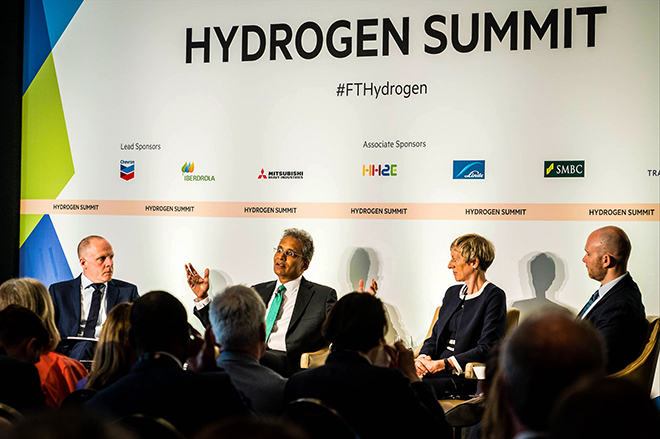S&P Global Offerings
Featured Topics
Featured Products
Events
S&P Global Offerings
Featured Topics
Featured Products
Events
S&P Global Offerings
Featured Topics
Featured Products
Events
Banking & Capital Markets
Economy & Finance
Energy Transition & Sustainability
Technology & Innovation
Podcasts & Newsletters
Banking & Capital Markets
Economy & Finance
Energy Transition & Sustainability
Technology & Innovation
Podcasts & Newsletters
S&P Global Offerings
Featured Topics
Featured Products
Events
17 Jun, 2022

By Camilla Naschert

| Speakers at the Financial Times' Hydrogen Summit in London on June 16. Source: Financial Times |
Despite vast capacity targets for green hydrogen worldwide, industry players are still stopping short of making the large commitments needed to deliver on ambitions, delegates at the Financial Times' Hydrogen Summit in London heard June 16.
"We're all just frozen [like] rabbits in the headlights, saying, 'Who's going first?'" Paddy Padmanathan, vice chairman and CEO of Saudi energy developer ACWA Power Co., said at the conference. "This is not rocket science. ... It's about somebody standing up and having the courage of conviction to say, 'I'm going to build this.'"
The European Union claimed a global pioneering role in the technological and commercial development of green hydrogen, having launched its hydrogen strategy in July 2020.
While the pipeline of announced projects in Europe has swollen to over 7.5 million tonnes of annual production by 2030, only a fraction of these have achieved a final investment decision — one example being the 2-MW H2RES pilot project being developed by Ørsted A/S in Denmark. Many developers cite uncertainty over the market framework and policy design as the missing pieces.
"You cannot only bet on the incumbents to make things happen," Pierre-Etienne Franc, CEO of hydrogen investment manager FiveT Hydrogen, said in an interview on the sidelines of the conference.
"The ones that are making this thing move are the disruptors, the entrepreneurs that are taking bold risks because they can," Franc said. "They are the ones we need to support so that the big ones move as well."
"We cannot be more ready," Jon André Løkke, CEO of Norwegian electrolyzer manufacturer Nel ASA, said during the conference. "We need to see [final investment decisions] start to flow, money start being made," the executive said, adding that the ball is in the European Commission's court.
In Europe, developers now have a good idea of the requirements for green hydrogen projects, thanks to the commission's delegated act on green hydrogen published in May. Rules around additionality — adding fresh renewables capacity to support electrolyzers — were laid out in the draft law, which is designed to avoid electrolyzers displacing green power from other parts of the system. The rules also exempt regions with a 90% share of renewables in the power mix already.
Some market insiders said the proposals would slow down cost declines and take some projects off the table due to their strict nature.
"Additionality doesn't make a project more bankable," said Jeroen Kies, head of project finance for Belgium, the Netherlands, Luxembourg and the Nordics at Japanese bank Sumitomo Mitsui Banking Corp. When projects need to document an hourly correlation with renewables production, they will become administratively more burdensome, Kies said.
Julien Rolland, head of power and renewables at commodity trading house Trafigura Ltd., concurred that additionality can be problematic for project economics. The rule will benefit projects outside of Europe, which are able to build electrolyzers and renewables capacity simultaneously — something that is challenging in a developed and power-hungry market like Europe.
"We need electrolyzers, but we don't have enough power to feed them," Rolland said.
Electrolyzer push
As it stands, the EU does not have the electrolyzer manufacturing capacity of the necessary scale either. To that aim, the commission launched an initiative for the development of European manufacturing on June 16, targeting an annual production capacity of 17.5 GW by the end of the decade, compared to 1.75 GW today.
Standards on safety, reliability and equipment durability are driving the development of the technology, said Alexey Ustinov, vice president of Cummins Inc.'s global electrolyzer division. Ustinov welcomed the EU initiative.
Concerns over price-based competition from Chinese manufacturers are overblown as the technology is further advanced in Europe, Ustinov said in an interview on the sidelines of the conference. "The safety regulations in Europe are so strict that they will create natural barriers," Ustinov said.
However, the industry is still grappling with reliance on countries such as China for raw materials used in the manufacturing of equipment. "That's where we don't have an answer yet," Ustinov said. Manufacturers ought to collaborate and work with the commission to identify sustainable sources of commodities as the industry scales up, the executive added.
Looking at global energy policy, an era of clean power domination is in sharper view than the incremental progress on the way there, according to Elizabeth Press, director of planning and program support at the International Renewable Energy Agency. "It is more clear what's going to happen in 2050 than what's going to happen in the next two to three years," Press said.
Designing and delivering a global hydrogen system, however, will not be an easy task, Press said during a panel discussion. "This is not a fuel replacement, this is a totally new system."
S&P Global Commodity Insights produces content for distribution on S&P Capital IQ Pro.
